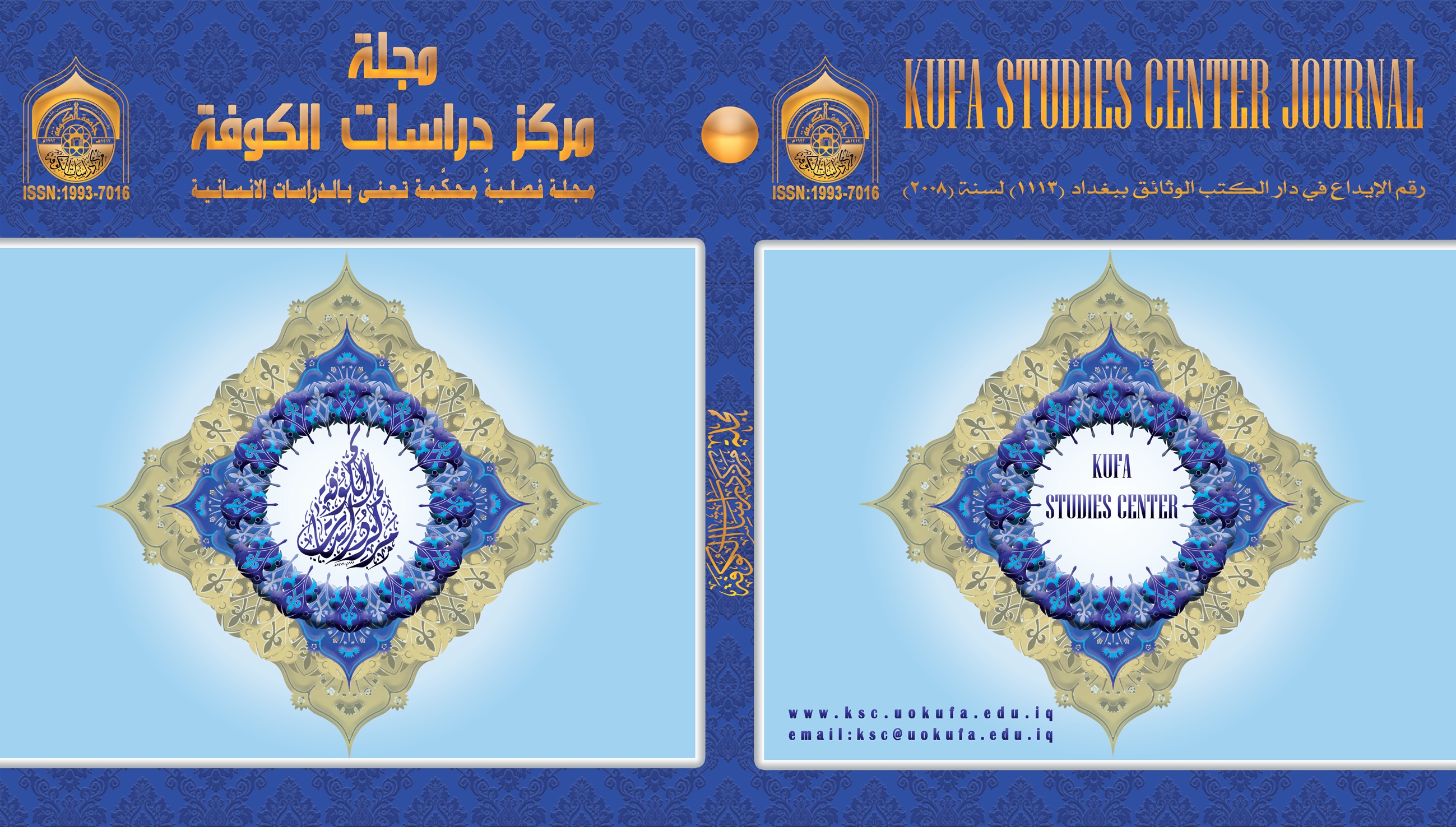Introducing the character through the non-dramatic narrator - a study in models of the Arabic novel
DOI:
https://doi.org/10.36322/jksc.v1i72.15846Keywords:
introduction, character, narrator, non-theater, techniquesAbstract
The study deals with the presentation of the character in the Arabic novel, which is a necessary technique for the novel and narration, and a way in which the novelist presents his characters in the novel, and it is meant the method that helps in clarifying the features of presenting the character through the events of the novel itself, and it depends on drawing the features of the character from the inside or the outside. To show the character in a clearer form and more details, and the multiplicity of methods of presenting the character in the narrative text, some of which are direct presentation and indirect presentation, including what combines the two methods of direct and indirect presentation; According to the method that the novel finds suitable to complete its final artistic form, and behind that lie indications and artistic overtones that are disclosed by that presentation.
the study with a summary from which we can discern the nature of the research
Downloads
References
-الروايات:
أم سعد: غسان كنفاني, دار منشورات الرمال – قبرص, ط1, 1969م.
السبيليات: اسماعيل فهد إسماعيل, نوفابلس للنشر – الكويت, ط1, 2015م.
القلق السري: فوزية رشيد, مؤسسة دار الهلال – البحرين, ط1, 1949م.
محاولة عيش، محمد زفزاف، مكتبة الادب المغربي – المغرب، ط1، 2004م.
نوار اللوز: واسيني الأعرج, دمشق- الجزائر, ط1, 1982م.
الكتب:
بنية الشكل الروائي (الفضاء- الزمن- الشخصية): حسن بحراوي, المركز الثقافي العربي- المغرب, ط2, 2009م.
تقديم الشخصية في رواية بابُ الطباشير لأحمد سعداوي: م.م. رغد حميد عبد الله, قسم اللغة العربية- جامعة الانبار , مجلة الآداب, ملحق العدد 128 آذار, 2019م.
تقنيات تقديم الشخصية في الرواية العراقية- دراسة فنية: أثير عادل شواي, دار الشؤون الثقافية – بغداد, 2009م.
جماليات الشكل الروائي: سوسن البياتي وعبيد محمد صابر, عالم الكتاب الحديث, ط1, 2012م.
الرؤية السردية والإيديولوجية في رواية (حكايتي مع رأس مقطوع) لتحسين كرمياني: ازاد محمد كريم الباجلاني, قسم اللغة العربية - كلية التربية الأساسية, بحث منشور – مجلة جامعة كرميان, 2018م.
السرد العربي القديم "الاشكال والمضامين": أ. خلف الله حنان, قسم اللغة العربية – جامعة محمد البشير الإبراهيمي- برج بوعريريج, بحث منشور, 2016م.
الشخصية في القصة: جميلة قيسمون, مجلة العلوم الانسانية – جامعة منتوري الجزائرية, ط13, د.ت.
قضايا الفن الأبداعي عند دوستويفسكي, باختين: ت.د.جميل نصيف, مراجعة د.حياة شرارة, دار الشؤون الثقافية – بغداد, ط1, 1986م.
المتخيل السردي (مقاربات نقدية في التناص والرؤى والدلالة): عبدالله إبراهيم, المركز الثقافي العربي, ط1, 1990م.
المصطلح السردي: جيرالد برنس, ت: عابد خزندار, مجلس الأعلى للثقافة – القاهرة, ط1, 2003م.
الوصف في الرواية الخليجية من مطلع القرن الحادي والعشرين وحتى 2019: حسام عبد العزيز, رسالة ماجستير, كلية الاداب- جامعة بغداد, اشراف الدكتورة كرنفال أيوب محسن, 2020م.
-Novels:
um Saad: Ghassan Kanafani, Al-Rimal Publishing House - Cyprus, 1st Edition, 1969 AD.
Al-Sabiliyat: Ismail Fahad Ismail, Novablus Publishing – Kuwait, 1st Edition, 2015.
Secret Anxiety: Fawzia Rasheed, Dar Al Hilal Foundation – Bahrain, 1st Edition, 1949 AD.
Attempt to live, Mohamed Zafzaf, Library of Moroccan Literature - Morocco, 1st Edition, 2004.
Nawar Al-Lawz: Wasini Al-Araj, Damascus - Algeria, 1st Edition, 1982 AD.
Books:
The structure of the narrative form (space - time - character): Hassan Bahraoui, Arab Cultural Center - Morocco, 2nd Edition, 2009.
Introducing the character in the novel Bab al-Shalk by Ahmed Saadawi: Eng. Raghad Hamid Abdullah, Department of Arabic Language - Anbar University, Journal of Arts, Supplement No. 128 March, 2019.
Techniques of presenting the character in the Iraqi novel - an artistic study: Atheer Adel Shuway, House of Cultural Affairs - Baghdad, 2009.
The Aesthetics of Novel Form: Sawsan Al-Bayati and Obaid Muhammad Saber, The World of Modern Books, 1st Edition, 2012 AD.
The narrative and ideological vision in the novel (My story with a severed head) by Tahseen Karmiani: Azad Muhammad Karim Al-Bajlani, Department of Arabic Language - Faculty of Basic Education, published research - Garmian University Journal, 2018.
The Ancient Arabic Narrative "Forms and Contents": Mr. Khalaf Allah Hanan, Department of Arabic Language - University of Mohamed Bachir Ibrahimi - Bordj Bou Arreridj, published research, 2016.
The character in the story: Jamila Kaismoun, Journal of Human Sciences - Mentouri University, Algeria, 13th Edition, D.T.
Issues of creative art according to Dostoevsky, Bakhtin: T. Dr. Jamil Nassif, reviewed by Dr. Hayat Sharara, House of Cultural Affairs - Baghdad, 1st Edition, 1986 AD.
The Narrative Imaginary (Critical Approaches in Intertextuality, Visions and Significance): Abdullah Ibrahim, Arab Cultural Center, 1st Edition, 1990 AD.
Narrative term: Gerald Prince, T: Abed Khaznadar, Supreme Council of Culture - Cairo, 1st Edition, 2003 AD.
Description in the Gulf novel from the beginning of the twenty-first century until 2019: Hussam Abdul Aziz, Master's thesis, College of Arts - University of Baghdad, supervised by Dr. Carnival Ayoub Mohsen, 2020.
Downloads
Published
How to Cite
Issue
Section
License
Copyright (c) 2024 أ.د. علي كاطع خلف، الباحثة ابتهال كاظم أحمد

This work is licensed under a Creative Commons Attribution 4.0 International License.
Permit others to distribute and copy the manuscript, to create extracts, abstracts, and other revised versions, adaptations, or derivative works of or from the manuscript (such as a translation), to include in a collective work, to text or data mine the article, even for commercial purposes, as long as they credit the author(s), do not represent the author as endorsing their adaptation of the article, and do not modify the article in such a way as to damage the author''''s honor or reputation. Further details are found at Creative Commons Attribution 4.0 International (CC BY 4.0)






























